
Growing brassicas and leaf crops from seed
Growing brassicas and leaf crops from seed
All members of the brassica family, except the spring greens, require a soil that is well supplied with organic material, while a spring dressing of a balanced fertiliser is beneficial. On all but alkaline soils, a dressing of hydrated lime in early spring is recommended.
To avoid the danger of soil-borne diseases such as Club root, Brassicas should be rotated round the garden so that they grow in a different site each year for 3 years. They should only be returned to their original plot in the fourth year.
All brassicas (including Chinese vegetables. Kohl rabi, Swedes and Turnips) should be rotated in the vegetable garden. Rotation helps to avoid a build-up of soil pests and diseases. At transplanting brassicas should be protected from cabbage root fly damage by the use of a fibre disc or square cut from old carpet underlay.
Borecole or Kale
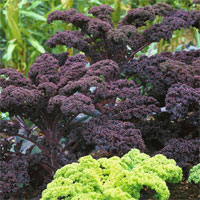
This is a hardy winter vegetable that will grow well in almost any type of soil. Seed is sown in spring 0.5 in (1.25cm) deep and the seedlings are transplanted in summer, allowing 18in (45cm) apart each way. Harvest a few leaves at a time from each plant.
Broccoli, Purple and White Sprouting
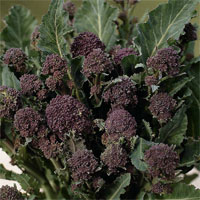
Sprouting Broccoli is an easily grown gourmet vegetable that gives the best return for the space it occupies and as a bonus is cropped when other green vegetables are in short supply.
One row of 15ft (4.5m) will accommodate six plants to give self-sufficiency for a family of four. Sow the seed in spring in a seed bed 0.5in (1.25cm) deep and transplant when the seedlings are about 4in (10cm) tall 2ft (60cm) apart each way. Cut the tender shoots, beginning with the centre, while the flower buds are still in a tight bunch and continue taking the shoots for up to seven weeks.
Brussels Sprouts
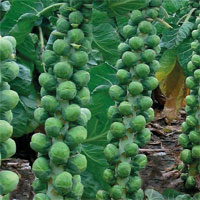
Sow in a seed bed 0.5in (1.25cm) deep from early to mid spring for transplanting in late spring or early summer 3ft (90cm) apart. Water the young plants before transplanting and firm the soil very thoroughly afterwards.
Cabbage
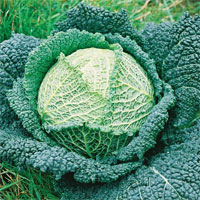
Raise the plants in a seed bed and transplant when the seedlings have made four or five leaves. Summer cabbage is sown in spring 0.5in (1.25cm) deep for planting out in early to midsummer 12-18in (30-45cm) apart. Winter cabbages are sown in late spring for planting in mid-summer 9-18in (23-45cm) apart. Planting distances have a major impact on the finished size of the cabbage; close planting results in small cabbages.
Calabrese
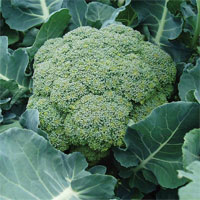
This follows the sprouting broccoli and can be sown successionally to give tender, succulent spears right through to early winter. Sow 0.5in (1.25cm) deep in early spring in the seed bed, and transplant to rows 20in (50cm) apart, allowing 12m (30cm) between the plants. Each plant should yield about 1lb (450g) of spears.
Cauliflowers
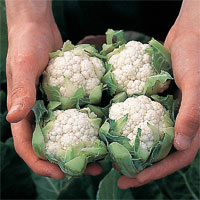
This crop is rather more fussy than the other brassicas. It needs an organically-rich soil and must never go short of water. It also needs a generous amount of space. For an early summer crop, sow the seed indoors in winter in trays and propagate at about 60-65F (15-18C). Transplant in early spring 18 x 24in (45 x 60cm) apart. Autumn maturing varieties are sown in a seed bed in spring and transplanted in early summer 24 x 28in (60 x 70cm) apart. Sow the seed 0.5in (1.25cm) deep, thin to 3in (7.5cm) apart and transplant when the plants have made five or six leaves.
Kohl Rabi
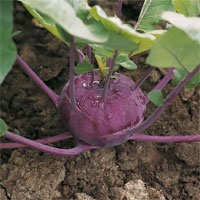
A delicious alternative to turnips and many people find it easier to grow. The edible part is the swollen stem which can be cooked whole or sliced when about the size of a tennis ball. Sow the seed in spring 0.5in (1.25cm) deep in rows 12in (30cm) apart for use in summer. Thin out to 4-6in (10-15cm) apart. Sow the winter crop in mid-summer.
Spinach
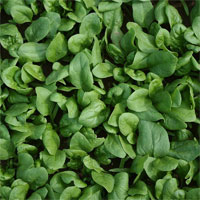
A highly nutritious and easily grown crop for use throughout the autumn, winter and spring.
Sow perpetual spinach in spring in drills 1in (2.5cm) deep 6in (15cm) apart, in rows 18in (45cm) apart, preferably in a well-manured organic soil in partial shade.
Pick young leaves regularly, starting late summer, and give some protection against frost to enable picking throughout the winter.
Summer spinach, such as Monnopa is treated in the same fashion and takes almost 9 weeks from sowing to picking, provided that the soil doesn't lack moisture. So make successional sowings at 2-3 week intervals until mid-summer.
Swiss chard
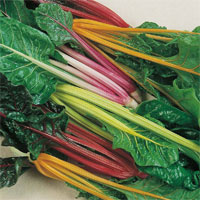
This is also known as seakale beet, silver chard and ruby chard. It is a dual-purpose vegetable: the leafy part being used as an excellent alternative to spinach while the thick, fleshy midribs are cooked and used like asparagus.
Sow as for spinach and harvest from late summer to late autumn. The foliage dies off during the winter but there is rapid regrowth in early spring.
Head to our brassica hub page to find out more about growing your own nutritious cruciferous vegetables.

Written by: Sue Sanderson
Plants and gardens have always been a big part of my life. I can remember helping my Dad to prick out seedlings, even before I could see over the top of the potting bench. As an adult, I trained at Writtle College where I received my degree, BSc. (Hons) Horticulture. After working in a specialist plantsman's nursery, and later, as a consulting arboriculturalist, I joined Thompson & Morgan in 2008. Initially looking after the grounds and coordinating the plant trials, I now support the web team offering horticultural advice online.Sign Up For Exclusive Special Offers




© 2024 Thompson & Morgan. All rights reserved. A division of Branded Garden Products Limited.



